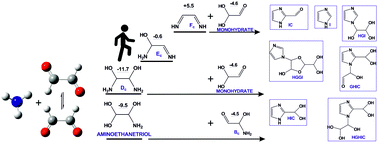Theoretical analysis of glyoxal condensation with ammonia in aqueous solution†
Abstract
The reactions of glyoxal with ammonia, ammonium salts, and amines cause the formation of the secondary organic aerosol (SOA) components (imidazole and its derivatives) in the atmosphere. The interaction of glyoxal and ammonia in aqueous solution is a primary reaction for these processes, and the explanation of its mechanism will allow developing the methods to control the formation of the SOA components. A detailed mechanism for the formation of key intermediates, namely, ethanediimine, diaminoethanediol, and aminoethanetriol, required for the imidazole ring cyclization, is proposed, and its potential energy surface (PES) has been constructed. This mechanism includes the experimentally identified intermediate compounds and takes into account the conformational and hydration equilibria of glyoxal. The schemes are proposed for further conversion of the key intermediates to the products of condensation between glyoxal and ammonia in the aqueous solution, C–N cyclic oligomers, that were identified. The products are shown to correspond to low positions on the PES in terms of Gibbs free energy, from −30.8 to −68.3 kcal mol−1, which confirms the high probability of their formation. The preferable thermodynamic pathway for formation of the imidazole products does not comprise the conversion of the diimine intermediate with the participation of the proton, but rather the interaction of either the diaminoalcohol with glyoxal monohydrate or two monoamine derivatives between themeselves (aminoethantriol and aminohydroxyacetaldehyde).



 Please wait while we load your content...
Please wait while we load your content...